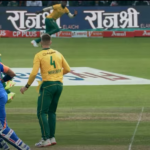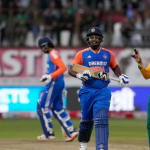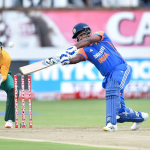South Africa Waiting Game As Net Run-Rate Threat Looms In T20 World Cup. In the world of cricket, particularly during major tournaments like the T20 World Cup, teams are often forced to endure nail-biting waits as their destiny is decided not by their own efforts, but by the performances of others. This is exactly the scenario that the South African women’s cricket team found themselves in after securing a seven-wicket victory against Bangladesh in their final group-stage match. Despite winning three out of four matches in their group, the looming threat of net run-rate (NRR) could yet derail their semi-final hopes.
The team’s journey to this point has been marked by both triumphs and challenges, but now they face the waiting game, hoping the results of other matches fall in their favor to secure a place in the knockout stages. Let’s dive into the story of their campaign, filled with strategic plays, moments of brilliance, and the ever-present pressure of NRR calculations.
A Strong Start, but Not Enough to Guarantee a Place in the Semis
The South African women’s cricket team entered the tournament with high hopes, beginning their campaign with a bang by dismantling the West Indies in a crushing 10-wicket victory. They followed that up with a commanding 80-run win over Scotland, a performance that seemed to cement their position as semi-final contenders. Yet, as is often the case in cricket, one loss — to England — threw their plans into disarray.
The loss to England meant South Africa had to win their remaining matches and hope that the calculations worked in their favor. Their next challenge came in the form of Bangladesh, a team they were expected to beat comfortably. However, cricket is never that straightforward, and while South Africa did secure the win, their decision to take 17.2 overs to chase down a modest target of 107 runs significantly hurt their net run-rate.
Going into the match, South Africa knew they needed a quick chase to improve their NRR and keep it above that of the West Indies. Unfortunately, the slower-than-expected chase saw their NRR drop from 1.5 to 1.38, a seemingly small margin that could prove to be critical in the final analysis. These fine margins are what make international tournaments like the T20 World Cup so thrilling — and so nerve-wracking.
The Tactical Approach Against Bangladesh
South Africa’s approach to their match against Bangladesh was one of calculated strategy. The pitch offered lively conditions for the bowlers, and the Proteas decided to open with pace bowling for the first eight overs, a move that no other team had attempted in the tournament up to that point. Marizanne Kapp and Ayabonga Khaka led the attack, finding swing early and reducing Bangladesh to a precarious 36 for 2 in the first eight overs.
However, with the absence of a third seam bowling option, South Africa had to turn to spin, and that’s where things started to unravel slightly. The discipline they showed early in the innings wavered, with the team conceding 11 wides and allowing Bangladesh to settle into their innings. Ultimately, the Proteas restricted their opponents to 106 — a target that, on most days, would be considered a manageable total, yet it wasn’t achieved without its challenges.
Despite the flaws in their bowling performance, the South African team had laid a solid foundation. What followed was a batting display that, while effective, lacked the speed and urgency needed to boost their NRR. Laura Wolvaardt, Anneke Bosch, and Tazmin Brits all had opportunities to accelerate the chase, but a combination of dropped catches and missed run-out opportunities meant that South Africa’s top order couldn’t fully capitalize on the situation.
Missed Opportunities and the Net Run-Rate Dilemma
In pursuit of 107, South Africa’s top three — Wolvaardt, Bosch, and Brits — tried to inject urgency into their innings, but all three were dismissed just three balls before South Africa needed to complete the chase to push their NRR above that of the West Indies. This left Kapp and Chloe Tryon to finish off the match, which they did with 16 balls to spare. A win was secured, but the failure to chase the target more quickly meant that South Africa’s net run-rate had taken a hit, putting their semi-final hopes in jeopardy.
The concept of net run-rate has been both a blessing and a curse for cricket teams across the world. For South Africa, it looms large as they now await the results of the final group-stage match between the West Indies and England. If England defeats both Scotland and the West Indies, South Africa will secure a spot in the semi-finals. However, if the West Indies manage to win, the dreaded net run-rate could come into play, potentially knocking the Proteas out of the tournament.
This scenario has left the team in a frustrating position, where all they can do is wait. As Tazmin Brits put it, “The most important thing is to stay close to each other and stay together as a unit.” The team knows they have done all they can, and now it’s up to the cricketing gods to decide their fate.
Paul Adams Inspirational Leadership
Throughout the tournament, South Africa’s spin bowling coach, Paul Adams, has played an instrumental role in keeping the team focused and motivated. Adams, a former South African cricketer who played in the 1996 ODI World Cup, has been a passionate figure in the team’s dressing room, delivering motivational speeches and even composing his own poetry to inspire the players.
Before the match against Bangladesh, Adams read out a poem titled “Stay in the Game,” which urged the team to remain present in the moment and not let doubt or fear take hold. This message seems to have resonated with the players, who have shown resilience and determination throughout the tournament. As Brits recalled, “He’s a very passionate man. In the previous game, he actually took off his shoes and put his feet on the ground and said, ‘We are grounded.’”
Adams’ ability to keep the team focused on the task at hand, even in the face of adversity, has been key to their success so far. His leadership has helped the players, especially the more experienced members like Brits, to maintain a sense of calm and perspective, even as the pressure mounts.
The Mental Game
With three days to go before they learn their fate, the South African team must now find a way to manage their emotions and stay mentally sharp. The waiting game is never easy, especially in a high-stakes tournament like the T20 World Cup, where every run and every ball can make the difference between success and failure.
For the South African players, the key will be to focus on what they can control — preparing for the possibility of a semi-final match and staying united as a team. As Brits noted, “We’ll just make sure we rest and get ready as if we are going to go to that semi-final. There’s no point having negative thoughts about it.”
This mindset will be crucial if South Africa are to progress further in the tournament. The team’s ability to stay grounded, as Adams has encouraged them to do, will help them navigate the uncertainty of the next few days. Whether they make it to the semi-finals or not, the Proteas can take pride in the fact that they have fought hard and performed admirably throughout the group stages.
The Bigger Picture
Regardless of the outcome of the group-stage matches, South Africa’s campaign in this T20 World Cup offers valuable lessons for the future. The team has shown that they have the talent and the tactical nous to compete at the highest level, but they will also be acutely aware of the fine margins that can make or break a tournament run.
In particular, the importance of net run-rate has been a harsh reminder of how crucial it is to not only win matches but to win them decisively. As the South African men’s team learned in the 2021 T20 World Cup, when they failed to chase down a target quickly enough against Bangladesh and missed out on a semi-final spot, every run and every over counts.
For the women’s team, this tournament has been a journey of growth and self-reflection. Players like Tazmin Brits, who tops the run charts for South Africa, have learned to be more forgiving of themselves, recognizing that cricket is as much a mental game as it is a physical one. As Brits said, “I’m trying to talk better to myself because I’m very strict with myself… but I want to do good for the team, especially being an opening batter.”
Conclusion
As the South African cricket team waits for the outcome of the group-stage matches, their fate hangs in the balance. While they have done everything within their control to secure a place in the semi-finals, the cruel nature of net run-rate calculations could still deny them a spot in the knockout stages.












